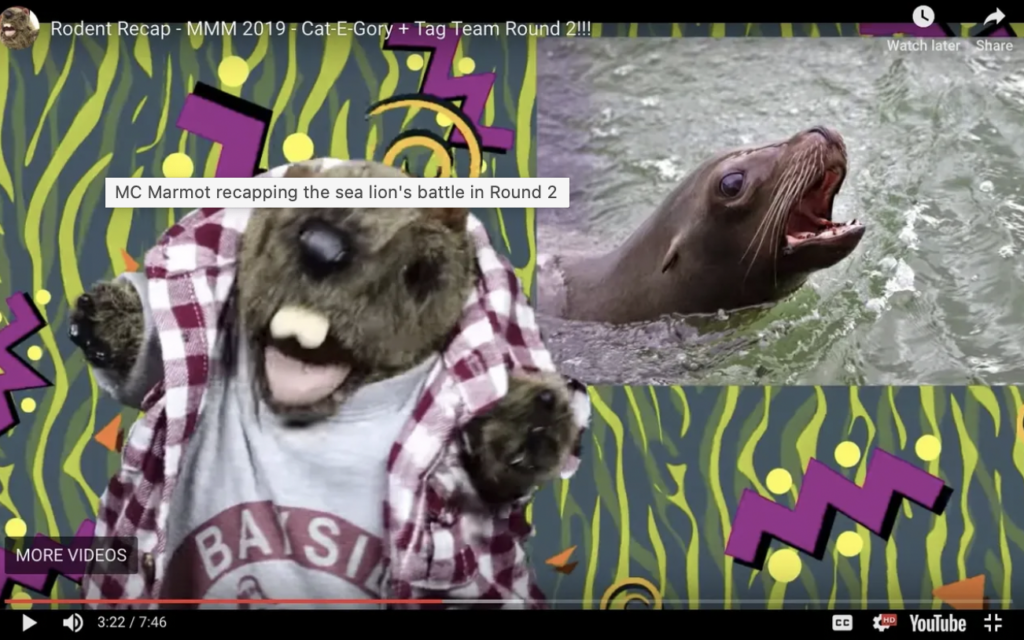
Have you heard about this? It is seriously my favorite time of year.
When students are inevitably getting hyped over college basketball and ask me who I’m rooting for, I always tilt my head and give them a puzzled look…then I insist that I only care about the real March Madness.
March MAMMAL Madness.

If you’re not familiar with this competition, head to the MMM libguide and start figuring out how to work it into your classes for next year. In a nutshell, this is how it works:
This was developed by Dr. Katie Hinde, a Professor of Evolutionary Biology and Senior Sustainability Scientist at Arizona State University. Every year, Dr. Hinde and a group of phenomenally talented and creative scientists get together and decide on four categories with 16 combatants per category. They seed them from 1 to 16 based on things like temperament, special skills, armory, weaponry, etc. Then on specific pre-set dates, the battles play out. I believe that the winner is generated by a computer program, but then the organizers create narrations of the battles and drop it scene by scene on Twitter! Summaries of each battle are uploaded on the blog, and there are even YouTube videos created with a puppet marmot summarizing the duels!

It’s SO fun, and there are a bunch of ways to incorporate it into the classroom.
MMM in Biology Class:
In addition to this being super fun and engaging, there is SO much learning that can be mined from this activity. The most obvious connections are in Biology, and incredible educator materials are put together each year for teachers to use with their classes. Lib guides have been created that allow your students to easily research the animals to determine what traits they might have that could come into play in their battles ahead. Students love it, and it’s a beautiful way to talk about diversity and evolution. You can keep an eye on their website and sign up for educator materials a couple of weeks before the competition begins to get all your ducks in a row.
Update for MMM 2020: I’ve also created a FREE set of graphic organizers designed for students to research a match-up between two animals. Categories include Size, Natural environment, Diet, Fight Style, Social behavior, temperament, and other considerations that might pop up during their research. This is an easy way to guide student research and prep them before filling out their brackets!
MMM in Math Class:
Confession: this year, much to my sadness, I don’t teach Biology. But does that keep me from participating in MMM with my students? Heck no! But I’ve certainly had to be a bit more creative in how I can incorporate it. I teach an enriched Year 8 Math class, and my MMM bulletin board is outside of our classroom. They have always been drawn to it, even when it was last year’s completed bracket. They were excited to fill out their own for 2019, and I thought there was potential for me to incorporate it into a math class of a bunch of kids who love math. Here are some ideas I have used:

1) Warm-up: Noah is in last place after 2 rounds. This is his bracket. What is the maximum score that he can get? Describe his path to this score. How feasible do you think this is given the potential match-ups? What score do you think he can realistically achieve?
2) Warm-up: These are the first and second place brackets after 3 rounds. Can the second place person beat the first place person? How?
3) Exploring Measures of Central Tendency: We can group the data in multiple ways. How? (Ex: by grade, by class, by science vs. math, etc.) Let’s look at the mean, median, and mode scores for these groups. Why do you think these differences exist? Why did the Year 8s do so much worse than the Year 10s? (I mean I know it’s because a third of them thought it would be HILARIOUS to go for the dandelion, but do they remember that about themselves??) This is an opportunity to really analyze their data and ask good questions.
4) Box Plots: This type of statistical representation was new for my students, but they liked it! We made box blots based on scores for each round, and they learned how to calculate some new concepts like interquartile range and outliers. It was an interesting way to visualize the spread of the data.

5) Building Relationships: Not everything you do has to be directly related to a requirement all the time. My students spent 30 minutes filling out their brackets on a Friday afternoon when I knew I wasn’t going to be able to get a lot of quality work out of them. They had fun telling me about their reasoning and showing me crazy videos and information about animals. I update them after each round and we applaud the leader. I tease the kid in last place because he’s in on the joke, and I let him select which math question he wants to put on the board today out of fake pity. It’s silly and it’s fun, and no one takes it too seriously.
Tonight is the Final ROAR! Will the sea lion take down the warthog/mongoose tag team? Will the moose beat the tiger? It’s anyone’s guess at this point, but my students and I will all be tuning in tonight to find out!
Scientifically yours,
Mo
Interested in other blog posts? Check out:
Spicing Up Teaching Diagrams in the Classroom



